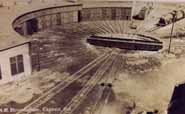
|
|
|

Continued Growth
|
The recently incorporated Town of Capreol began to boom just prior to the 1920's. By 1919, the Canadian Northern Railway had built sixty houses however, this was still highly inadequate for the number of men needed to work the railway. To relieve this situation, a Young Men's Christian Association (YMCA) was built and opened in 1921. The YMCA served as not only a rooming house for the men, but also as a social and sports centre for the town.
Many additions and community improvements were conducted throughout the 1920's and 1930's.
In 1920, two and a half miles of hydro electric distribution systems were installed with electricity being supplied by the CNR.
 By 1925, the Capreol train yard had grown in size and the roundhouse was enlarged to house 20 pits, reflecting the increasing traffic and growing importance of this junction. This was further highlighted during the war years. Being part of the transcontinental line, with tracks leaving Capreol in three directions - east, west, and south to Toronto - troops and equipment could easily be dispatched wherever they were needed. By 1925, the Capreol train yard had grown in size and the roundhouse was enlarged to house 20 pits, reflecting the increasing traffic and growing importance of this junction. This was further highlighted during the war years. Being part of the transcontinental line, with tracks leaving Capreol in three directions - east, west, and south to Toronto - troops and equipment could easily be dispatched wherever they were needed.
Capreol citizens were provided with household telephones in 1927. No longer were they restricted to calling Sudbury from the single pay phone located at the CNR station.
A town hall followed in 1929, housing the town office, the fire station, the council chambers, the office of the chief of police, and the jail.
Four church congregations were also established to minister to the spiritual needs of the residents: Trinity United Church; Capreol Baptist Church; St. Alban's Anglican Church; and Our Lady of Peace Church (Roman Catholic).
By 1930, the installation of water and sewage systems were complete. This helped to change the residential landscape of the community from sand and gravel to beautiful lawns, flower beds, and vegetable gardens.
|

|
|

|
 |

 Greater Sudbury Guestbook
Greater Sudbury Guestbook
 Home Page
Home Page
 Greater Sudbury Histories
Greater Sudbury Histories
 Continued Growth
Continued Growth
 By 1925, the Capreol train yard had grown in size and the roundhouse was enlarged to house 20 pits, reflecting the increasing traffic and growing importance of this junction. This was further highlighted during the war years. Being part of the transcontinental line, with tracks leaving Capreol in three directions - east, west, and south to Toronto - troops and equipment could easily be dispatched wherever they were needed.
By 1925, the Capreol train yard had grown in size and the roundhouse was enlarged to house 20 pits, reflecting the increasing traffic and growing importance of this junction. This was further highlighted during the war years. Being part of the transcontinental line, with tracks leaving Capreol in three directions - east, west, and south to Toronto - troops and equipment could easily be dispatched wherever they were needed.


